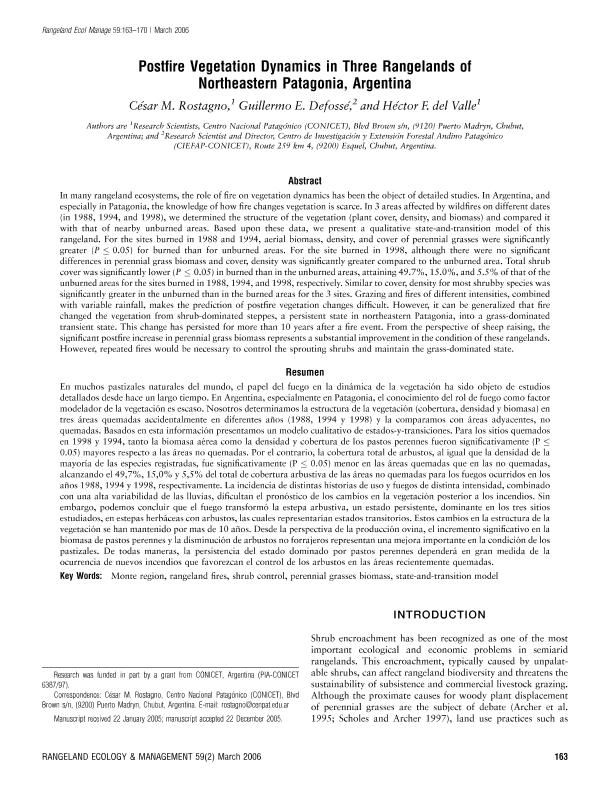Mostrar el registro sencillo del ítem
dc.contributor.author
Rostagno, Cesar Mario

dc.contributor.author
Defossé, Guillermo Emilio

dc.contributor.author
del Valle, Hector Francisco

dc.date.available
2020-05-05T17:54:31Z
dc.date.issued
2006-03
dc.identifier.citation
Rostagno, Cesar Mario; Defossé, Guillermo Emilio; del Valle, Hector Francisco; Postfire Vegetation Dynamics in Three Rangelands of Northeastern Patagonia, Argentina; Society for Range Management; Rangeland Ecology and Management; 59; 2; 3-2006; 163-170
dc.identifier.issn
1550-7424
dc.identifier.uri
http://hdl.handle.net/11336/104264
dc.description.abstract
En muchos pastizales naturales del mundo, el papel del fuego en la dina´mica de la vegetacion ha sido objeto de estudios detallados desde hace un largo tiempo. En Argentina, especialmente en Patagonia, el conocimiento del rol de fuego como factor modelador de la vegetacion es escaso. Nosotros determinamos la estructura de la vegetacion (cobertura, densidad y biomasa) en tres a´reas quemadas accidentalmente en diferentes an˜os (1988, 1994 y 1998) y la comparamos con a´reas adyacentes, no quemadas. Basados en esta informacion presentamos un modelo cualitativo de estados-y-transiciones. Para los sitios quemados en 1998 y 1994, tanto la biomasa aerea como la densidad y cobertura de los pastos perennes fueron significativamente (P 0.05) mayores respecto a las a´reas no quemadas. Por el contrario, la cobertura total de arbustos, al igual que la densidad de la mayorı´a de las especies registradas, fue significativamente (P 0.05) menor en las a´reas quemadas que en las no quemadas, alcanzando el 49,7%, 15,0% y 5,5% del total de cobertura arbustiva de las a´reas no quemadas para los fuegos ocurridos en los años 1988, 1994 y 1998, respectivamente. La incidencia de distintas historias de uso y fuegos de distinta intensidad, combinado con una alta variabilidad de las lluvias, dificultan el pronostico de los cambios en la vegetacion posterior a los incendios. Sin embargo, podemos concluir que el fuego transformo´ la estepa arbustiva, un estado persistente, dominante en los tres sitios estudiados, en estepas herbaceas con arbustos, las cuales representarian estados transitorios. Estos cambios en la estructura de la vegetacion se han mantenido por mas de 10 años. Desde la perspectiva de la produccion ovina, el incremento significativo en la biomasa de pastos perennes y la disminucion de arbustos no forrajeros representan una mejora importante en la condicion de los pastizales. De todas maneras, la persistencia del estado dominado por pastos perennes dependera en gran medida de la ocurrencia de nuevos incendios que favorezcan el control de los arbustos en las areas recientemente quemadas.
dc.description.abstract
In many rangeland ecosystems, the role of fire on vegetation dynamics has been the object of detailed studies. In Argentina, and especially in Patagonia, the knowledge of how fire changes vegetation is scarce. In 3 areas affected by wildfires on different dates (in 1988, 1994, and 1998), we determined the structure of the vegetation (plant cover, density, and biomass) and compared it with that of nearby unburned areas. Based upon these data, we present a qualitative state-and-transition model of this rangeland. For the sites burned in 1988 and 1994, aerial biomass, density, and cover of perennial grasses were significantly greater (P 0.05) for burned than for unburned areas. For the site burned in 1998, although there were no significant differences in perennial grass biomass and cover, density was significantly greater compared to the unburned area. Total shrub cover was significantly lower (P 0.05) in burned than in the unburned areas, attaining 49.7%, 15.0%, and 5.5% of that of the unburned areas for the sites burned in 1988, 1994, and 1998, respectively. Similar to cover, density for most shrubby species was significantly greater in the unburned than in the burned areas for the 3 sites. Grazing and fires of different intensities, combined with variable rainfall, makes the prediction of postfire vegetation changes difficult. However, it can be generalized that fire changed the vegetation from shrub-dominated steppes, a persistent state in northeastern Patagonia, into a grass-dominated transient state. This change has persisted for more than 10 years after a fire event. From the perspective of sheep raising, the significant postfire increase in perennial grass biomass represents a substantial improvement in the condition of these rangelands. However, repeated fires would be necessary to control the sprouting shrubs and maintain the grass-dominated state.
dc.format
application/pdf
dc.language.iso
eng
dc.publisher
Society for Range Management

dc.rights
info:eu-repo/semantics/openAccess
dc.rights.uri
https://creativecommons.org/licenses/by-nc-sa/2.5/ar/
dc.subject
RANGELAND FIRES
dc.subject
PATAGONIA
dc.subject
TRANSITION MODELS
dc.subject
ARGENTINA
dc.subject.classification
Silvicultura

dc.subject.classification
Agricultura, Silvicultura y Pesca

dc.subject.classification
CIENCIAS AGRÍCOLAS

dc.title
Postfire Vegetation Dynamics in Three Rangelands of Northeastern Patagonia, Argentina
dc.type
info:eu-repo/semantics/article
dc.type
info:ar-repo/semantics/artículo
dc.type
info:eu-repo/semantics/publishedVersion
dc.date.updated
2020-04-22T15:38:18Z
dc.journal.volume
59
dc.journal.number
2
dc.journal.pagination
163-170
dc.journal.pais
Estados Unidos

dc.journal.ciudad
Boulder, Colorado
dc.description.fil
Fil: Rostagno, Cesar Mario. Centro de Investigación y Extensión Forestal Andino Patagónico; Argentina. Consejo Nacional de Investigaciones Científicas y Técnicas; Argentina
dc.description.fil
Fil: Defossé, Guillermo Emilio. Consejo Nacional de Investigaciones Científicas y Técnicas; Argentina. Centro de Investigación y Extensión Forestal Andino Patagónico; Argentina
dc.description.fil
Fil: del Valle, Hector Francisco. Consejo Nacional de Investigaciones Científicas y Técnicas; Argentina. Centro de Investigación y Extensión Forestal Andino Patagónico; Argentina
dc.journal.title
Rangeland Ecology and Management

dc.relation.alternativeid
info:eu-repo/semantics/altIdentifier/url/https://www.sciencedirect.com/science/article/abs/pii/S155074240650017X
dc.relation.alternativeid
info:eu-repo/semantics/altIdentifier/doi/http://dx.doi.org/10.2111/05-020R1.1
Archivos asociados
